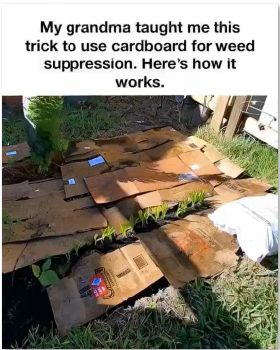
Gardening is such a lovely and fulfilling hobby, but tackling those pesky weeds can feel a bit overwhelming at times. Some folks turn to chemical herbicides or plastic mulches, but these can be tough on the environment. I’m so glad my grandma shared a classic, eco-friendly way to keep weeds at bay using just some cardboard! This natural solution is really effective and sustainable, and I’m thrilled to share this knowledge with fellow gardeners!
Challenges Posed by Weeds in Gardens
Weeds can be quite the pesky problem! They tend to compete with your plants for nutrients, water, and sunlight. This competition might hold back the growth of your flowers, vegetables, and other crops, which can impact your garden’s yield in the end. Weeds can invite pests and diseases, which can put your garden’s health at risk. Managing these weeds while keeping the positive elements of your garden intact can be a bit tricky.
Why Cardboard Is a Great Solution
Cardboard is a fantastic option for keeping weeds at bay because of its thickness and eco-friendly nature. Cardboard is a great alternative to plastic sheets! It lets water and nutrients seep into the soil while keeping sunlight out, which helps stop weed seeds from sprouting. Unlike plastic, it won’t suffocate the soil. As time goes by, cardboard naturally breaks down and adds organic matter to the soil, making it a wonderful choice for keeping your garden healthy in the long run.
Things You’ll Need: 1. Cardboard sheets (ideally without shiny prints or too much ink)
You’ll need a box cutter or some scissors to cut the cardboard.
3. A garden hose or a watering can
4. Organic mulch like straw, wood chips, or compost
5. Garden stakes or rocks to keep the cardboard in place
A Friendly Step-by-Step Guide to Using Cardboard for Weed Suppression
Here’s a friendly, step-by-step guide to using cardboard in your garden to suppress weeds:
Getting Your Garden Area Ready
Begin by figuring out which spots in your garden you’d like to keep free of weeds. Let’s clear away any large weeds and debris from these areas to make a nice, flat surface. Make sure to water the garden bed well so the soil is nice and moist. This will help the cardboard stick to the ground and kickstart the decomposition process!
Putting Down The Cardboard
Next, cut the cardboard into easy-to-handle pieces and lay them flat on the prepared garden area. Make sure the pieces overlap by at least six inches to keep any weeds from sneaking through the gaps. If you need to, feel free to use a box cutter or scissors to shape the cardboard around your plants and garden edges.
Covering the Cardboard Layer
After you have the cardboard set up, go ahead and add a nice layer of organic mulch on top! The mulch will help keep the cardboard in place and add an extra layer of protection against weeds. Evenly spread the mulch to create a lovely layer that’s about two to three inches thick. This will not only keep those pesky weeds at bay but also help your soil stay moist and maintain a comfy temperature.
Tips for Watering and Maintenance
Once you’ve spread the mulch, give the whole area a good watering to help the cardboard settle in and start breaking down. During the growing season, be sure to check the mulch layer from time to time and add more if needed to keep it nice and thick. When the cardboard breaks down, it will help nourish the soil, and you can easily add fresh layers of cardboard at the beginning of each planting season.
Advantages of Choosing Cardboard Compared to Other Options
Using cardboard as a weed suppressant brings many benefits:
1. It’s budget-friendly and can even be free if you have some old boxes at home!
2. It is good for the environment and breaks down naturally, helping to enrich the soil.
It helps steer clear of the possible risks associated with chemical herbicides.
4. It lets water and nutrients flow to the soil, unlike plastic barriers.
5. It offers a helpful way to use recyclable materials that could otherwise be wasted.
Common Mistakes and Tips to Steer Clear of Them
Here are a few mistakes you might want to steer clear of:
1. Using glossy or heavily inked cardboard, which might have some harmful chemicals.
2. Make sure to overlap the cardboard well to prevent weeds from finding any gaps.
3. Not using enough mulch to hold down the cardboard.
4. Forgetting to water or take care of the mulch layer. By keeping these points in mind, you can make your weed suppression process even more effective!
Wrapping Up and Final Reflections
Using cardboard for weed suppression is an easy and effective method that can really enhance your gardening experience. This method, shared with me by my grandma, is not only effective but also fits perfectly with sustainable gardening practices. By preparing properly and maintaining your garden regularly, you can effectively manage weeds and enjoy a healthier, more productive space. If you’re an experienced gardener or just beginning your journey, why not give this method a go? You might be surprised by the positive impact it has on your garden!

